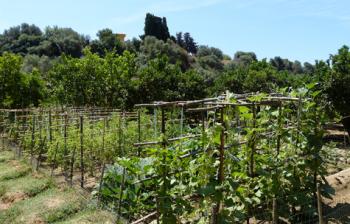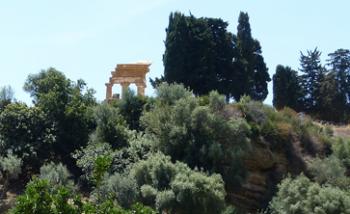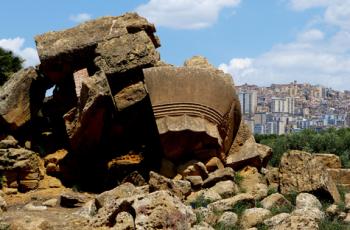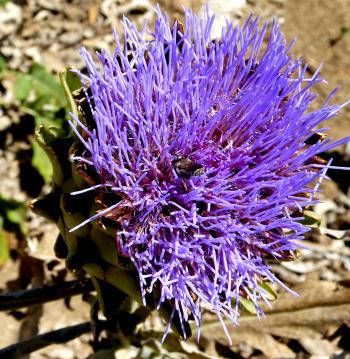The Garden Path
This item appears on page 51 of the November 2016 issue.
This is the first in a series of three articles on gardens in Sicily. I visited the island at the bottom of Italy’s boot in June 2016 as a guest on the land portion of Overseas Adventure Travel’s “Sicily’s Ancient Landscapes & Timeless Traditions” itinerary (Oct. ’16, pg. 18). It’s important to note that the three gardens written about, while located in areas visited, were not part of the tour itinerary. I researched the gardens, made my own contacts and, in the tour program’s free time, paid the admission charges and visited them. — YMH
Valley of the Temples’ hidden garden
(Part 1 of 3 on Sicily)
As we followed our guide through the Magna Graecia structures dedicated to the gods and built by the rulers of the prosperous and influential city of Akragas, I wondered why this UNESCO archaeological site is known as the Valley of the Temples.
Easily understood was the “temple” part, as we were walking through the remarkable ruins of seven built between what has been estimated at at least 510 and 430 BC. All, however, are located on a high ridge just outside the Sicilian town of Agrigento, as Akragas is now known. Perhaps “Ridge of the Temples” didn’t ring quite right.
Among the stately edifices, some remarkably intact, the Temple of Olympian Zeus lies in a magnificent tumble.
It was designed to commemorate the 480 BC battle of Himera, in which the cities of Akragas and Syracuse defeated the Carthaginians. Defeated soldiers captured after the battle provided slave labor for what was conceived to be the largest Doric temple ever built.
For whatever reasons, the temple was never completed. Through the centuries, time and events took their toll, leaving today the Temple of Olympian Zeus in picturesque rubble.
Carthaginian slave-labor hands, however, did complete the digging of a deep lake fed by an intricate system of aqueducts and directed, clay-brick channels. Although its primary purposes were to be a water reservoir and a source of farmed freshwater fish, with its flora-reflected waters and swans floating by, the lake provided a pleasurable spot to visit.
Lake-to-garden transformation
Fast-forward 15 centuries to the Arab arrival in Sicily. Agrigento was no longer the resplendent city of builders of Magna Graecia temples to mythical gods. With the city now inhabited by Greek Orthodox Christians, the temples’ origin and meaning had been long forgotten. Sheep grazed among the structures.
Their agriculture was among the many lasting gifts the Arabs brought with them. In a far corner of the ridge, they came upon the remains of the lake, now obliterated with overgrowth, and saw it as a garden. They planted citrus, vegetables, fruit and nut trees, bananas, sugarcane and date palms carried from their native land.
With the Arabs’ departure 220 years later, in the 16th century the church took over Kolymbetra’s maintenance. The garden became a major tourist stop for Grand Tour travelers until, in the 1980s, the water supply failed. Abandoned once again, the garden descended into a jungle of brambles.
In 1999, the National Trust of Italy stepped in, removing overgrowth and restoring terraces, ancient aqueducts and irrigation systems. What could be rejuvenated in the garden was pruned and inventoried, with new trees and plants put in place according to ancient maps. In 2001, the historic 5-hectare (12.3-acre) garden reopened to the public.
Exploring the garden
On the ridge, vendors were enjoying a lively business selling colorful paper parasols on the hot and dusty June 2016 day of my Overseas Adventure Travel (OAT) visit to the temples. With three temples yet to go, I slipped away to find Kolymbetra.
A sign near the Temple of Dioscuri pointed the way to a flight of rustic stone-and-earth steps that delivered me into what was once the bottom of the lake, a lush oasis from the sun-baked, ancient ruins above.
A detailed plan of the garden was the first of a series of excellent signs explaining, in English and Italian, the history and significance of the garden and the plants. From them, I learned that citrus orchards are called “gardens,” emphasizing their beauty and fragrance as well as usefulness; that the vegetable garden is planted with varieties that in years past were those transported to market by mule, including courgettes, aubergines, tomatoes and peppers; that the olive tree with the massive twisted trunk is estimated to be 800 years old, and that the sugarcane thickets growing along the stream that crosses the garden were in place in 1225.
Ancient systems of irrigation, including the tunnel aqueduct excavated by Carthaginian slaves along with gravity-flow, clay-tiled channels, continue to deliver water throughout Kolymbetra today.
The dry and craggy, ravine-like edges of the garden were densely covered in Mediterranean maquis — tough, native, scrubland shrubs and trees. An occasional tree had found foothold in the maquis. I spotted fig and olive and what I learned later was a Mediterranean fan palm, the only palm that grows wild in the Mediterranean basin.
The ruined remains of the Temple of Dioscuri beckoned above the maquis, reminding me that I must make my way back through Kolymbetra’s cool and quiet pathways to rejoin my OAT travel companions. Our meeting place was the Temple of Olympian Zeus, its backdrop the modern-day city of Agrigento.
I could not help but feel pleased that those Carthaginian slaves, instead of completing the magnificent tumble we were standing before, had been put to work digging out a lake. Temples on the ridge fell into ruins with the passing centuries, during which the excavated site metamorphosed from lake to garden, encompassing Sicilian history from ancient times to today.
The Valley of the Temples (phone +39 360 397 930) is open daily 8:30 a.m. to 7 p.m. The entry fee is €10 (near $11). For information, visit www.valleyofthetemples.com and (in Italian only) www.parcovalledei templi.it.
Kolymbetra (phone +39 335 1229042, email faikolymbetra@fondoambiente.it or visit www.fondo ambiente.it) is open daily 10 a.m.-6 p.m., with the exception of Jan. 7-31. The latest entry time is one hour before closing. Although Kolymbetra is within the Valley of the Temples, it carries a separate entry fee of €4.
Email Yvonne Michie Horn at yhorn@sonic.net. Also visit www.thetravelinggardener.com.




